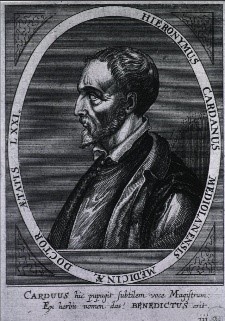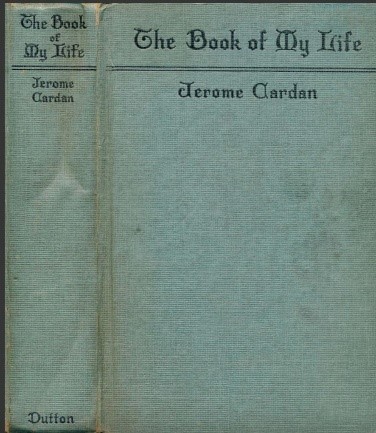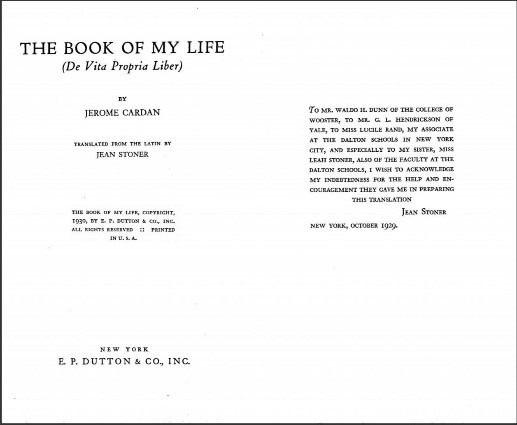In this guest post by David Benjamin, we explore a little of the life and times of Girolamo Cardano and his interesting family.
Girolamo Cardano (1501- 1576) was at various times in his life a physician, mathematician, inventor, addictive gambler and prisoner. He was the illegitimate son of Fazio Cardano and Chiara Micheria, and the Cardano family was a dysfunctional 16th Century version of the Simpsons.
Girolamo Cardano was one of the first people to work on probability theory and to consider the square root of negative numbers. His most famous invention, still in use today, is a mechanical component used in motor vehicles called the Cardan Shaft. Square roots of negative numbers appeared in his Ars Magna, a book on algebra written in Latin and published in 1545.
His father, Fazio, was a Milanese lawyer and lecturer in Geometry at the University of Pavia and later at the Piatti foundation in Milan and was a friend of Leonardo da Vinci, who consulted him on geometry.
He met Chiara, a widower with three children, when he was in his fifties but they did not marry until much later. The plague in Milan made Chiara, who was pregnant with Girolamo, move to Pavia shortly before the birth, leaving her three children in Milan, where tragically all of them were killed by the plague.
Girolamo switched between mathematics, medicine and gambling as circumstances dictated. His illegitimate birth and difficult personality led to his initially being denied entry to the College of Physicians – in his autobiography, The Book of My Life, he wrote:
This I recognise as unique and outstanding amongst my faults – the habit, which I persist in, of preferring to say above all things what I know to be displeasing to the ears of my hearers. I am aware of this, yet I keep it up wilfully, in no way ignorant of how many enemies it makes for me.
In 1531 Girolamo married Lucia, the daughter of a neighbour in Padua, and they had two sons – Giambastia and Aldo – and a daughter, Chiara. Family problems were never far away – Lucia died in 1546 and their children did little to enhance the family reputation.
His eldest son Giambastia, who had become a doctor in 1557, married Brandonia di Seroni, who Girolama described in his autobiography as a “worthless and shameful woman“. Giambastia poisoned his wife, possibly because she taunted him in public about not being the father of their three children. Following the trial, Giambatista was sent to prison where he was tortured, his left hand was amputated and he was executed on 13 April 1560.
Girolamo was devastated, especially as he could have saved his son from execution if he had been able to afford a settlement to the Seroni family offered by the trial judge. As the father of a convicted murderer, he became a hated man and realised he had to move away. He applied for and was appointed professor of medicine at the university of Bologna – where his aggressive tactlessness enraged his colleagues, who tried to get him dismissed.
His second son Aldo was also an addicted gambler who gambled away his own possessions and much of his father’s money. In 1569 he broke into his father’s house and stole jewellery and money. Girolamo reported the break-in and Aldo was banished from Bologna.
In 1570 Cardano was found guilty of, and jailed for, heresy, after he cast a horoscope of Jesus Christ and wrote a book in praise of Nero, the tormentor of the martyrs.
He was released from jail after serving just a few months, mainly because of the intervention of some influential friends who felt the sentence to be too harsh. He subsequently moved to Rome where he was given immediate membership of the College of Physicians and Pope Gregory XIII granted him a pension.
Cardano forayed into the then untouched realm of probability theory in his book Liber de Ludo Aleae, published in 1663, but believed to have been completed in 1563. His experience as an addictive gambler and expert chess player clearly helped develop his theory. In the book he considered the probabilities when rolling one, then two and finally three dice and also calculated the probability of the outcomes from the sum of the faces of two dice. In Chapter 5 he gives his motivation for writing the book:
Gambling … would seem to be a natural evil. For that very reason it ought to be discussed by a medical doctor like one of the incurable diseases. … It has been the custom of philosophers to deal with the vices in order that advantage might be drawn from them, as, for example, in the case of anger.
Among Cardano’s many achievements were the invention of the Cardan Shaft (pictured above), the invention of the combination lock, and his work on the gimbal. The Cardan shaft is the mechanical component for transmitting torque and rotation with the help of a universal joint connecting the gear box to the rear axle of a car, and is named after the English version of his name, Jerome Cardan. Although he did not invent the gimbal, it is sometimes called the ‘Cardan suspension’ following his detailed descriptions of its workings.
Cardano was a brilliant and troubled man: a polymath. In addition to his work on mathematics he published two encyclopaedias of natural science, and was once described as ‘the best doctor in the world’, following the reputation he gained from successfully treating many grateful influential patients.
His fame produced offers from heads of state in Europe for medical advice, and in 1552 he accepted an offer of money from John Hamilton (the Archbishop of St Andrews) who was close to death after suffering from asthma for over 10 years. The Archbishop paid Cardano 1400 gold coins for his service and let him know that after two years he was completely cured.
While in Rome, Cardano wrote an autobiography which was published posthumously and with translations at various times from the Latin into Italian, French, German, English and Dutch.
In his autobiography he wrote of the four greatest sadnesses of his life :
The first was my marriage; the second, the bitter death of my son; the third, imprisonment; the fourth, the base character of my youngest son.
Cardano was probably not aware while writing his autobiography that his daughter Chiara had died of syphilis, caught whilst plying her trade as a prostitute, nor that Aldo had betrayed him to the Inquisition for which he (ironically?) was rewarded with the job of Bologna’s official torturer and executioner.
Cardano’s legacy in mathematics is great, but he’s also recognised in other ways – the asteroid 11421 Cardano was discovered in 1999 on the main belt between Mars and Jupiter and is named in his honour, as is the lunar impact crater Cardanus located in the western part of the Oceanus Procellarum.



Good read :-)
David, wow! wot a story. many thanks,
Keith.
Im always curious how.the cardano family get here in the philippines..
We in my family are great painter, musician, and great in math.
Cool – Let me know if you find out anything else!
I remember my grandfather talked about him, and he name one of my uncle to him. Until now, Im still curious how are we related to him and how the cardano family came here on the Philippines.
We in my family are great painter, musician and also in Mathematics.
Cool – Let me know if you find out anything else!
Hi David, you wrote an interesting and important contribution.The life of Gerolamo Cardano deserves a documentary. He seems to have been an extraordinarily innovative and daring Renaissance man, immersed in practical life problems, which he had been resolved to tackle and actually did. In optical side view, he had a rare noble aquiline-nosed profile that could be portrayed by a charismatic actor. Cheers EPK.